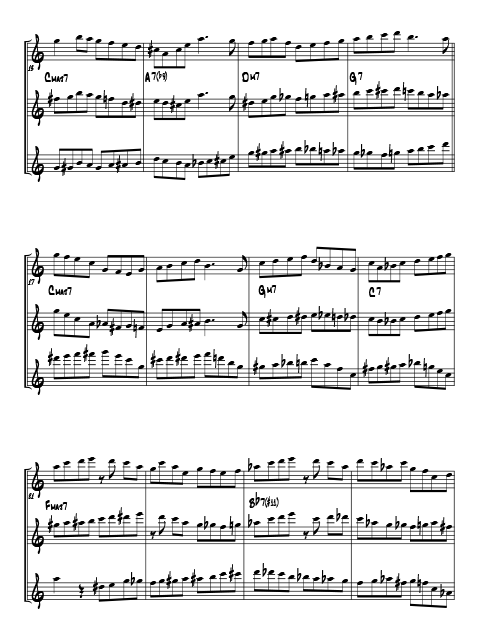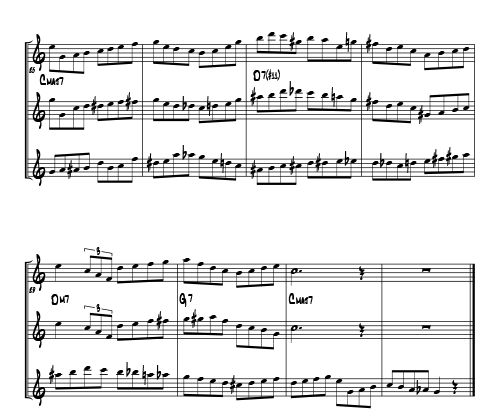Rick Margitza on Weaving Through Chord Changes Using Chromatic Embellishment

This is a general term that I use that includes the use of the descending be-bop scale (half step between the root and dominant 7th) and all the various versions of the ascending and descending major be-bop scales…check out the many videos on this subject that are based on the teachings of master Barry Harris. Under this general heading, I also include the use of upper and lower approach notes (half steps above or below the target chord tone) and enclosures: the use of both upper and lower approaches. Clifford Brown comes to mind as a master of this technique.
I’ve found that most younger, more inexperienced players tend to avoid or shy away from these “avoid” notes. As a result, their lines tend to sometimes sound awkward because the guide tones end up falling on weak parts of the measure. Besides the color that these passing/approach tones add, one of their main functions is to place the target notes on the strong beats of the measure.
That being said, I feel that it is extremely important to be able to master the technique of NOT using these chromatic notes – i.e. to improvise using nothing but the appropriate major or melodic minor scales. The goal here being to develop the ability to hear and feel the “right notes in the right places.” Once you are able to confidently hear and play melodies without the use of these “avoid” notes, the chromatic passing tones and enclosures become natural extensions of your melodic conception, thus adding color and interest to your lines. With these two concepts in mind, I offer the examples below.
- Line 1 is an improvisation over the chord changes of Cherokee. I used nothing but the notes in the corresponding major or melodic minor (lydian dominant chords) scales.
- Line 2 is based on the melodies and melodic shapes of line 1, but added are chromatic embellishments.
- Line 3 is and ultra embellished version that is not based on either of the two other examples. It is perhaps a little over the top chromatically, but I went out of my way to show how effective the use of chromatic passions tones and enclosures can be. In these examples, the objective was to illustrate the concepts mentioned above and are mostly 8th note based. Rhythmic variety is purposefully ignored.
CLICK HERE FOR A MORE READABLE AND PRINTABLE PDF VERSION OF THE SHEET MUSIC


Note that at no time am I thinking of any harmonic tensions or extensions…only scales and chromatic embellishments. Once these two techniques are absorbed and become second nature, the next step would be to start altering the chords and harmony. The perfect example of this logical progression would be John Coltrane from his Prestige through Impulse periods.
More from Rick
From Rick’s series of Etudes based on standards:
All The Things You Are
Go to the link above, and share on Twitter or Facebook to get a discount!
 Check out Gypsy Tenors by Rick Margitza & Gabor Bolla Tony Lakatos on Amazon Music. Stream ad-free or purchase CD’s and MP3s now on Amazon.com.
Check out Gypsy Tenors by Rick Margitza & Gabor Bolla Tony Lakatos on Amazon Music. Stream ad-free or purchase CD’s and MP3s now on Amazon.com.






Saxophonist Tony Lakatos Shares His Musical Journey And The Importance of Attitude » Best. Saxophone. Website. Ever.
April 4, 2020 @ 10:36 am
[…] The last big project I did was called The Gypsy Tenors with Rick Margitza, and another great Hungarian player named Gabor Bolla, who is based in Europe. I also have my own […]